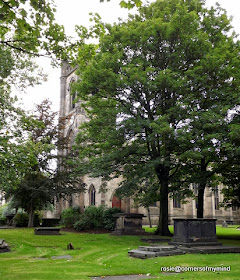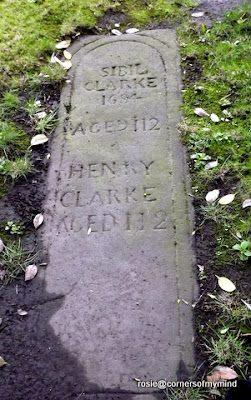Stoke Minster, formerly the church of St Peter ad Vincula, became Stoke Minster in 2005 and stands on Glebe Street opposite the Kings Hall and present Civic Centre in the town of Stoke. Stoke is one of the six towns which make up the city of Stoke-on-Trent the others being Hanley which is the city centre, Burslem known as the Mother town, Tunstall, Fenton and Longton.
The church we see now was designed by James Trubshaw and built in 1826 but there have been earlier churches on this site
The first church was a wooden building founded in the 7th century, the first stone church was built around 805 and this was altered and added to over the years the chancel being completely rebuilt in the 13th century.
In the churchyard is the remains of a Saxon Cross which dates from the 8th century
Close by are the tombs of the Spode family whose factory premises still stand in the centre of Stoke. The tomb on the left is the resting place of Josiah Spode I and his wife Ellen. This Josiah was credited with the introduction of underglaze blue transfer printing and the using of bone ash to make bone china.
In the churchyard are also the remains of the older stone building. The arches below were reassembled in the 1880s with stones from the Saxon church which were found in the water course of Boothen Mill. The inscription on the stones above reads 'site of the altar and sanctuary of the ancient church'
Behind the arches you can see the iron railings which protect the very plain resting place of the great potter Josiah Wedgwood I. He was buried at the entrance of the earlier church - demolished in 1829 - as he was a non conformist and not a member of the Church of England.
In complete contrast to the simplicity of Wedgwood's stone that of Herbert Stansfield, late of Middlewich is decorated with an elaborate carving of the coat of arms of the Free Masons and other masonic symbols.
If you read my last post you will remember the memorial inscription below to Sibil and Henry Clarke who both, according to the stone mason, appear to have lived to the age of 112. I couldn't just leave this and had to follow up with a bit of research.
I looked at microfiche of the Parish Registers transcribed by the Staffordshire Parish Registers Society in 1914, edited by Percy W L Adams from Wolstanton. Using the index I found references to Clark, Clarke, Clerk and Clerke and looked at them all on the fiche for 1629 to 1688.
I found the entry for the burial of Sibil Clarke as Sibylla Clerk on 24th December 1684, with a note in brackets added by the editor referring to her age on the gravestone. I looked at the other references to the variations on the Clark name and found two children born to Henry and Sibil Clarke as follows:-
16th June 1633 - Elizabeth, fil Henrici Clerke and Sibilla
and 15th October 1636 Henricus f Henrici Clerke and Sibilla
If Sibil was 112 in 1684 she would have been born in 1572 so in 1633 she would have been around 61 and in 1636 she would have been 64! Using the 1914 index I couldn't find a marriage recorded for Henry and Sibil in the registers, they could have been married elsewhere of course, also I couldn't find a burial for Henry. He did crop up one more time in the registers in 1674 when he was mentioned in a year end report as joint finance officer with an Isaac Key. Although that Henry could, of course, by then have been Henry the son of Henry and Sibil Clarke. I think by looking at the parish registers I've raised even more questions than I had before but if the Sybil and Henry Clarke mentioned in the registers are the ones recorded on the gravestone then there is no way they could have been aged 112. It's unlikely that there was another Henry and Sibil Clarke not mentioned in the registers so it seems to me that the ages on the gravestone are probably not true.
Right, after all that I'm off to watch Inspector Montalbano.
Have a great rest of the weekend
Right, after all that I'm off to watch Inspector Montalbano.
Have a great rest of the weekend











How very interesting. I didn't know Stoke had a minster but it looks like an interesting place and with a lot of history.
ReplyDeleteIt is quite fascinating isn't it? I do wish Stoke would make more of its history and heritage:)
DeleteThat was a fascinating post Rosie or should I say Inspector Rosie :) x
ReplyDeleteHa - researching family history is very like detective work at times:)
DeleteIt's all about detective work isn't it Rosie. Loved all your research and thanks for sharing it.
ReplyDeletePatricia x
Indeed it is! I enjoyed the exercise but I'm not the wiser really:)
DeleteReally interesting. I think we as a city sometimes underplay our history x
ReplyDeleteI agree Amanda there are some fascinating aspects to the history of the area but it just seems to get lost somewhere:)
DeleteFascinating stuff Rosie. As Amanda says, Stoke's history is undersold. The potteries, and the breweries both make interesting subjects xxx
ReplyDeleteI think it may be that working in the potteries was seen as just a job whereas some of the skilled workers were artists and crafts people but never seemed to 'blow their own trumpet' at all. My next door neighbour used to gild cups and saucers - such a delicate job - but doesn't see it as at all special:)
DeleteThere is always a mystery when searching parish records. Thanks for the update.
ReplyDeleteThere certainly is! Glad you enjoyed the further tales of Sibil and Henry:)
DeleteIt seems Josiah was a very popular name! How frustrating about Sibil and Henry Clarke! How could they be put down as 112 when they died? It makes you wonder how many other untruths lay undiscovered!!!
ReplyDeleteI wonder if it was their combined ages? Just a thought! Josiah was a popular name in the 18th century when both Wedgwood and Spode were around:)
DeleteA really interesting post. I've driven round Stoke a few times but never made the time to look at the churches. I'm definitely going to come back for this one! Jx
ReplyDeleteIt is easy to overlook the church as it is on a main road and looks a bit run down but there is so much history there:)
DeleteIt is fascinating that a church has been on this site since Saxon times. It is a shame we can only imagine what the original church looked like.
ReplyDeleteI expect it was fun researching the Clarkes. Clearly they weren't both 112 when they died, so the mystery is why were they recorded as being that age.
Such a tantalising mystery about the Clarkes. I wonder what the first wooden chuch looked like and the later one - I must see if there are any engravings or book plates in the archives:)
DeleteAn enjoyable and interesting post - well done with the research.
ReplyDeleteThanks Elaine, I enjoyed the detective work:)
DeleteNice to see you closer to home. You'll have to take us there the next time we come. The Potteries, like so many urban landscapes, deserves more attention and is full of gems and facets which need celebrating. More please - even a part three about another historic urban Potteries church, factory, civic building or even a, seemingly, plain old street. One of the best yet. I loved it.
ReplyDeleteYou must come on a day that the church is open as we keep missing it and I want to take photos inside - I have been in there a couple of times when I worked at Glebe Street you could pop in with your lunch and listen to a piano recital. Will do my best with part two:)
DeleteMy partner is from the Potteries and has a strong link to Stoke. An interesting and overlooked part of the world. I do love your title - it's so very evocative
ReplyDeleteIt is very overlooked and has quite a colourful history as well, there does seem to be a collective dismisal of any history about the place being of interest:)
DeleteI don't know how I missed this interesting post, Rosie. Possibly because we've been away. Stoke Minster looks like an interesting place with some famous connections and other fascinating details in the churchyard. Thanks for sharing more about your follow-up research on the Clarke gravestone mystery, too.
ReplyDeleteThanks, Linda - I'm still waiting to go inside - the Minster isn't open very often. I have been in before but didn't take photos at the time. The Clarkes are still a bit of a mystery:)
DeleteFascinating about Henry and Sybil. Clerks! Interesting that the Spodes and Josiah Wedgwood are buried here. I've never given any thought to their burial places until reading this.
ReplyDeleteThere are several generations of the Spode family in the churchyard. I only saw a reference to Josiah Wedgwood's grave but no doubt there are other Wedgwoods too. The Clarkes/Clerkes are a mystery:)
Delete